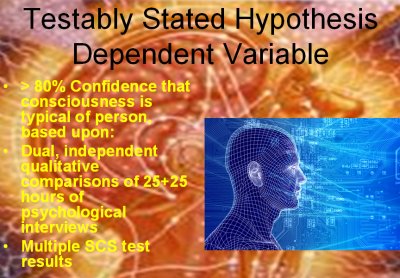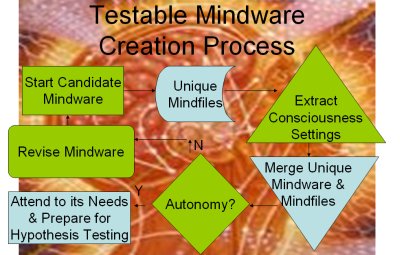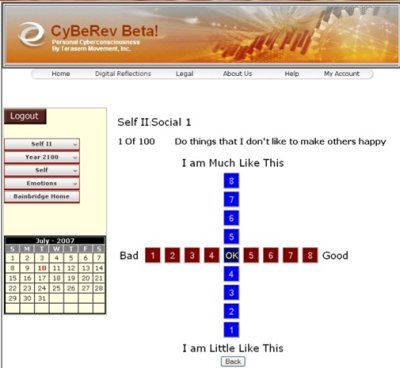An Experiment to Test the Ability of Digitally-Stored Mindfiles to Regenerate the Consciousness from Which It Came
Martine Rothblatt, Ph.D.
Page 2 of 4
This is the basis for my proposal of a .8 probability correlation between two separate teams of two psychologists all agreeing that a cyber conscious individual represents the same consciousness as an originally flesh conscious individual. In such case, the cyber conscious individual can in fact be said to be the conscious continuation of the original flesh individual.

Image 3: Dependent Variable

Image 4: Independent Variable
With these two sets of qualitative and quantitative tools we may indeed have an empirically testable hypothesis, because we have an empirically measurable dependent variable.
Now let's turn to the independent variable, which is the mindware that would be used to regenerate consciousness from stored, digital reflections of an individual's consciousness.
I define "mindware" as an operating code that adjusts its parameters to process information so as to produce consciousness based upon its associated database of reflections of consciousness. The database function would specifically be the reflection of an original subject's consciousness.
Once the operating system's parameters are adjusted to mimic the patterns of thinking, and the evidence of consciousness of the original subject, it saves itself as a mindfile subset form the mindware. Thereafter the mindware becomes, in fact, a conscious entity, a cyber conscious entity, or at least a purported cyber conscious entity that can be then tested in terms of the dependent variable.
I'd also like emphasize the importance here of specific informed consent. I believe this would be quite wrong and inappropriate to try to create a cyber consciousness from mindfiles that are not accompanied by specific informed consent from the provider of the database of mindfiles (reflections of consciousness).
So the next chart basically summarizes the mindware creation process. In the upper left hand corner we start with Candidate Mindware. And I'm certain there will be many, many different forms of Candidate Mindware during the process of testing this hypothesis. The Candidate Mindware dictates and processes a set of unique mindfiles deposited pursuant to informed consent.

Image 5: Mindware Creation Process
In the upper right hand corner, the Candidate Mindware extracts consciousness settings from those mindfiles. In the lower right hand corner, it then mergers the unique mindware, based on the consciousness settings, with the original mindfiles in the process.
The result is a unique, one of a kind, operating system that either does or does not evidence autonomy. If it does not  evidence autonomy, it needs to go back to the drawing board, and in the middle of the left margin, revise our mindware, and try a different form of mindware.
evidence autonomy, it needs to go back to the drawing board, and in the middle of the left margin, revise our mindware, and try a different form of mindware.
But in the lower right hand corner, if the development operating system does have an autonomy, we then attend to its needs. Which basically means ensuring that it has as good a quality of life as can be provided, such as access to communication and information, and prepare it for hypothesis testing in accordance with its informed consent.
What are the sources of mindfiles? One source of mindfiles are two websites that now exist and include an opportunity for individuals to deposit reflections of their consciousness, together with informed consent, for the operators of the website to endeavor to collapse their reflections of consciousness into actual cyber consciousness.
Once such web portal is at www.CyBeRev.org [1]. One of the tools at the CyBeRev website contains over 100,000 questions that were developed by the noted social psychiatrist, and National Science Foundation Manager, Dr. William Sims Bainbridge, III [2].

Image 6: Dr. Bainbridge's Personality Capture Questions
The informed consent that one can find at CyBeRev.org specifically asks each individual: Do they consent to be revived as cyber consciousness?
Participants are also asked do they consent to be downloaded into a bio-nano or cellular regenerated substrate?
The individuals who provide informed consent have the option to consent to either remain as a virtual entity or to be downloaded, when possible, into a bio-nano or cellular regenerated substrate to continue their life with that form of mobility and sensation.
The hypothesis we're testing can also be rephrased as saying that consciousness is immanent within mindfile psychometrics. We don't know if that's true or not until we prove or disprove the hypothesis with Candidate Mindware that can extract the immanent into the manifest.
This experiment poses several additional questions -- Why use psychologists as our tools for measuring the dependent variable? What's magical about twenty-five hours? Why measure twenty-five hours before and after to see if we accurately captured consciousness? How about automation and consistency? If it's going to be hugely labor-intensive to spend so many hours in therapy, and how about the medical ethics of these experiments?
The reason I propose to use psychologists to measure our variables is that psychologists are routinely used in our society and relied upon to determine mental states.
Footnotes
1. www.CyBeRev.org - CyBeRev means cybernetic beingness revival. The purpose of the CyBeRev project is to prevent death by preserving sufficient digital information about a person so that recovery remains possible by foreseeable technology. Terasem Movement, Inc. believes that future technology will be able to recover full functionality for CyBeRev people. (Read more)
http://cyberev.org/ April 1, 2008 2:14PM EST
2. William Sims Bainbridge III, Ph.D. - (born October 12, 1940) is an innovative American sociologist who currently resides in Virginia. He is co-director of Human-Centered Computing at the National Science Foundation (NSF) and also teaches sociology as a part-time professor at George Mason University. He is also the first Senior Fellow to be appointed by the Institute for Ethics and Emerging Technologies. Bainbridge is most well known for his controversial work on the sociology of religion; recently, however, he has published work studying the sociology of video gaming.
http://en.wikipedia.org/wiki/William_Sims_Bainbridge April 1, 2008 2:32PM EST
1 2 3 4 Next Page>